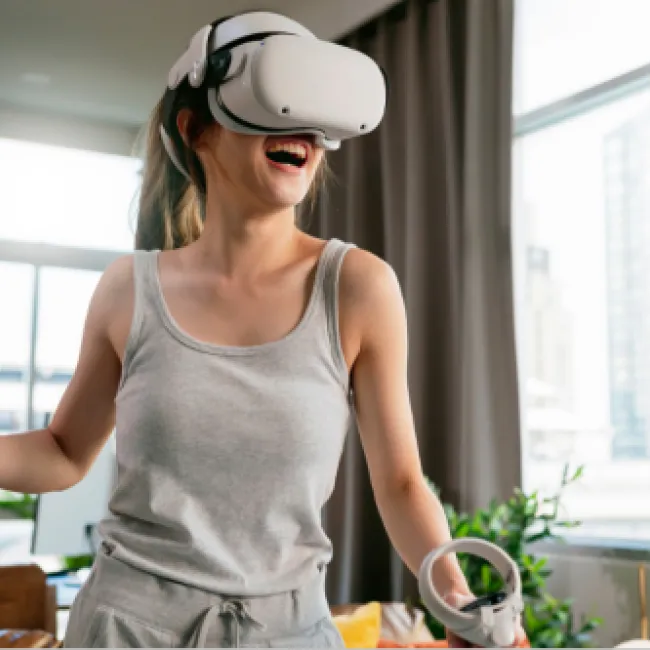
Adding a little variety to your workout, trying out what is possible virtually and burning a few calories in the process, or even learning new moves and techniques: virtual and augmented reality games and applications are increasingly finding their way into everyday life - also in sports training. According to ARtillery Intelligence, global sales in the virtual reality market were around 12 billion US dollars in 2022. In 2021, it was still around 8 billion. And the forecast for the coming years continues to point upwards. Reasons enough to take a closer look at the trend.
What is Virtual and Augmented Reality Training?
Augmented reality (AR) means that a user can use a device to bring digital objects into the real world and interact with them. This is possible, for example, via the screen of a smartphone or via a virtual reality headset in which virtual reality glasses are integrated.
In principle, AR is not new in the world of sports: when fans can see the team digitally played into the real, empty football field via their mobile phone camera during broadcasts of football matches, AR technology is behind it. In many stadiums, too, the audience finds its way to the seat by means of AR: the smartphone camera is pointed at the rows of seats and the correct path is digitally displayed. The digital elements are thus superimposed on the real world, so to speak. The real and digital worlds meet on the device.
In contrast to AR, virtual reality (VR) takes place entirely in virtual space. The user experience differs in that training or playing takes place in a virtual world, instead of "fading in" virtual elements into the training in the real world. AR and VR technology offer a wide range of possibilities, especially for fitness training, also in relation to digital courses in the gym. Most games require the respective software, a PC or a smartphone on which the corresponding app is loaded, and a VR headset.
Three examples for VR- and AR-Training
1. Dance-Workouts: In the virtual disco
Dance sport is an interesting example because of the large social component. Which aspects of it can be implemented alone, for example at home in the living room - without a dance partner? When the game is started and the VR headset is put on, the user finds himself in a virtual dance studio or disco. With the appropriate games, users can learn new choreographies, repeat steps of a virtual 3D dance teacher or get tips from him.
Using AR technology, you can learn the basic steps of a dance: you hold the smartphone camera to your own feet and see the dance step sequence superimposed on the display. Beginners can practise the steps this way. Of course, the real dance partner cannot be replaced. Rather, VR and AR technology make it possible to add another, playful component to dancing or to approach practising alone differently.
2. Boxing: Suddenly at the ring
You've always wanted to know what it feels like to stand in a boxing ring, but you'd like to avoid the pain of a real boxing punch? VR gaming makes it possible. Before the fight starts, there is usually a lot of training. For example, before the virtual player is allowed to enter the ring, he has to practice on the punching bag and punching ball under the guidance of a coach and get on the treadmill.
One thing is certain: If you commit yourself accordingly, the game can actually become a sweaty workout in the real world as well. In addition to the usual VR equipment (PC or smartphone app with the respective game, VR headset with VR glasses), you usually play with VR boxing gloves.
3. Golfing: The top golf course in your living room
Enormous space requirements and sometimes high costs can make it difficult for interested people to get into golf. Against this background, there are special opportunities for VR golf. This allows golf to be played in the gym or - with the appropriate equipment - at home in the garden or even living room. The player starts the PC or the smartphone app with the respective game, puts on the VR headset with the VR goggles, grabs the VR golf club and already finds himself on one of the world's top golf courses.
He now plays in the virtual 360-degree space, for example, as part of a golf course. He actually performs the movements with the VR golf club, but sees himself in the virtual world of the golf course via the VR glasses and receives tips and feedback from the virtual caddy to improve his own technique.
Depending on the game, the training can also be supplemented on a golf course in the real world using AR technology. With an electronic golf ball and the AR glasses, statistics on the tee shot are displayed. Particularly practical for beginners: the glasses can be used to track exactly where the golf ball has landed.
Tips: If you feel like trying virtual reality training at home, be sure to remove any furniture that may be in the way. Place pets in another room if necessary. Warming up beforehand and wearing the appropriate sportswear also reduces the risk of injury when playing VR games. After all, you are actually performing the movements.
Source:
Statistics on the worldwide VR market: https://de.statista.com/statistik/daten/studie/318536/umfrage/prognose-zum-umsatz-mit-virtual-reality-weltweit/, accessed at 13.02.2023.